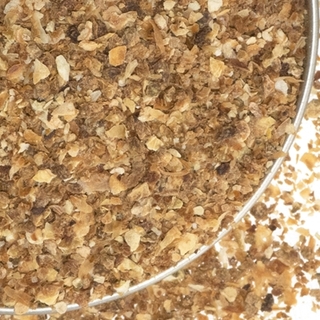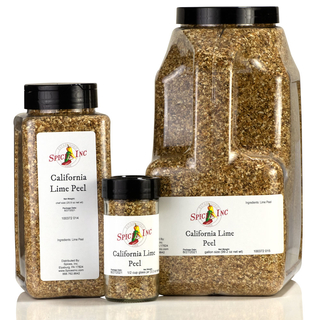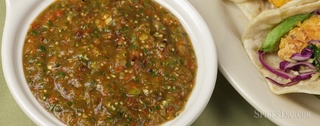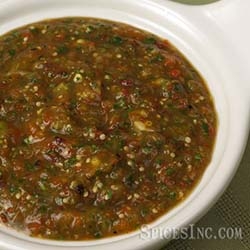Lime Peel




Lime Peel
Dried Lime Zest
Dried Lime Zest, Citrus × latifolia (Persian Limes) and Citrus × aurantiifolia (Key Limes), is also called dried lime peel, lime peel, or dehydrated lime zest.
Dried Lime Zest has an essential oil content of between 1.5% - 2.5%.
What is Dried Lime Zest
This is made from the outer lime peel, with most of the white part of the rind, called the pith (may contain up to 2.5% pith), being avoided. The pith gives a bitter flavor, while the zest contains the highest oil content and the most pleasing flavor, which is the reason it is so popular with our craft brewers and distillers.
History of Limes
The lime is an interesting fruit, with a history of over 4,000 years. The exact origin of limes is not known with some food historians believing that they are native to India and others to China. Plant geneticists believe that limes are a chance seedling, with citron, Citrus medica and papeda, Citrus cavaleriei or Citrus latipes possibly being its parents. These plant geneticists believe wild limes are most likely native to Indonesian or the nearby mainland of Asia.
It is believed that around 1000 BC that Arabian traders transported limes and lemons from India to many places including the eastern Mediterranean and parts of Africa.
The first written European record of limes in Europe come from a book called Travels by Sir Thomas Herbert during the 17th century. He wrote about seeing limes growing in Mozambique, which is a country in Africa. During the 19th century, British sailors had a set allowance for citrus daily, in the hopes of preventing scurvy. Originally this allowance was made up of lemons, but limes soon found their way into the rotation. In fact, limes became so commonly the choice of citrus for British sailors that sailors were simply referred to as "Limey" while back on shore.
It is thought that limes came to the United States as seeds with Christopher Columbus. Written records from colonies, in what is now Florida from 1560, establish that there were lime trees growing in that region at the time. Persian limes likely originated in Southeast Asia, this variety of lime was dubbed the “Tahitian” lime in the mid-1800s when it was imported to the United States from Tahiti and began to be grown in Florida and California. This was when the commercial lime industry really started taking off in the United States.
The growth of the lime industry was steady and with the growth of Latin American immigration into the US (from less than one million in 1960 to nearly 19 million in 2010) the demand for limes continued to rise and lime production in the US peaked in the 1980s. But the U.S. consumer’s appetite for limes did not wane and today Americans consume 10 times the amount they did in the 1980. In the 1990s the Florida Lime industry was hit by hurricanes which destroyed large amounts of lime trees which drastically curtailed the amount of domestic limes in the market. Mexico stepped in and started exporting Mexican grown Key limes into the U.S.
In the early 2000s Florida was hit a death knell to the lime industry with a disease called citrus canker that attacked lime trees and left them for dead. Local municipalities then restricted the addition of any new lime trees as they were worried that this disease would spread to the state's more powerful orange and grapefruit industry. Today most of limes in the U.S. are imported from Mexico.
Lime Cultivation
Lime trees can grow in soil with a sandy loam or clay loam texture, though the lighter, sandy loam soil is best for the shallow-rooted tree. These trees need full sun light of at least six to eight hours a day, with an ideal growing temperature of 60-85°F. Lime trees do not do well with temperatures below 50°F for prolonged periods. Lime trees thrive in a warm, moist climate with annual rainfall between 80 and 150 inches and they do tolerate drought better than any other citrus fruit. When there is excessive rainfall, the tree is subject to fungal diseases.
Budding onto sour orange or rough lemon seedling rootstocks is the primary means used to propagate commercially grown lime trees. 'Budding' refers to specific type of grafting that is best suited for the propagation of citrus trees. In bud grafting, a bud, along with some bark (called the budwood), is removed from small seed planted lime tree (called the scion) the grower is trying to propagate. The scion is typically the top part of the grafted plant. This scion is then grafted to the rootstock.
There are two primary reasons for grafting lime trees instead of growing from seed. Seed grown trees tend to have a shorter life span due to the higher likelihood of root rot. Seed grown trees also take longer to bear fruit, 4-10 years if at all, while grafted grown trees typically bear fruit in as little as 2-3 years.
Lime trees reach an average height of between 15 and 20 feet. The trees can live as long as 50 years and the average yield of a fully mature tree is 30 - 50 lbs of fruit per year.
Mexico and Brazil are the world’s leading producers if lime.
Where Are Dried Lime Peels From
Depending on the time of year and availability the limes we source come from either Mexico or the U.S.
What does Dried Lime Zest Taste Like
Slightly sweet yet bitter flavor, while the aroma is tart and sour.
What Can You Do With Dried Lime Zest
This is a popular ingredient for brewers, distillers and makers of tea blends. Dried Lime Zest is a great way to add fruit flavor to sweet and savory food. Dried citrus zests, whether we're talking orange, lemon, grapefruit, or lime, are not a pour out of the bag replacement for a freshly zested piece of citrus. But, when used properly, you can bring the volatile and aromatic oils found in the skin of the fruit back to life and elevate numerous recipes. When combined with a bit of liquid, you'll instantly recognize the floral and tangy aroma of lime, as well as the sophisticated bitter flavor this fruit is known for.
Pair our Dried Lime Zest with just about any kind of chile pepper for an unbeatable flavor combination that works as a coating for chicken or fish, or as a base of flavors for Roasted Salsa Verde. Toast with shredded coconut and use to garnish rice, or cook rice in coconut milk with lime peel. Infuse into vinegar, oil, or as an extract in a clear alcohol. Put in a quick marinade, with some garlic and thyme, for chicken or seafood. Steep in heavy cream and make lime cheesecake, mix into vanilla ice cream and re-freeze for ice cream sandwiches, or pulverize with some sugar to make lime cooler cookies.
Several of our Brew Master customers continue to buy this Dried Lime Zest, as it is a perfect addition to their sour ales. The dried peel retains much the lime's flavor profile which compliments beers hopped with a citrus character. We've also been told that lime peel works well in Citra hopped IPAs.
Dried Lime Zest pairs well with bell pepper, black beans, brown rice, butter, chicken, chile peppers, coconut, eggs, fish, garlic, olive oil, peanuts, pumpkin seeds, and toasted sesame.
To rehydrate, add three parts water to one part peel and let stand for about 15 minutes. Drain off water and you’re good to add to your recipe. To get even more flavor during rehydration replace some of the water with real lime juice.
Dried Lime Zest Substitution
Dried Lime Peel is much more potent than fresh lime peel, so you only need 1/3 of the amount of dried peel when fresh zest is called for in a recipe.
| Ingredients | Lime Peel |
| Also Called | Dried lime peel, lime peel, or dehydrated lime zest |
| Recommended Uses | Beer (especially sour ales), black beans, chicken and seafood marinades, rice, and salsa |
| Flavor Profile | lightly sweet yet bitter flavor, while the aroma is tart and sour |
| Oil Content | 1.5% - 2.5% |
| Botanical Name | Citrus × latifolia or Citrus × aurantiifolia |
| Cuisine | Mexican, Latin American, Mediterranean, and Middle Eastern |
| How To Store | Airtight container in a cool, dark place |
| Shelf Life | 1-2 years |
| Country of Origin | USA or Mexico |
| Dietary Preferences | Gluten Free, Kosher, Non-GMO |
Hungry for More Information
Craft Brewers Favorite Beer Spices
Volatile Oils of Spices
Flavor Characteristics of Spices
Sweet and Bitter Flavors
Nutrition Facts
Serving Size1 tsp
Amount Per Serving
Calories7
% Daily Value*
Total Fat0g0%
Saturated Fat0g0%
Trans Fat0g
Polyunsaturated Fat0g
Monounsaturated Fat0g
Cholesterol0mg0%
Sodium0.7mg0%
Total Carbohydrate1.6g1%
Dietary Fiber1.2g5%
Total Sugars0.2g
Added Sugars0g0%
Sugar Alcohol0.0g
Protein0.2g0%
Vitamin D0mcg0%
Calcium14mg1%
Iron0mg0%
Potassium15mg0%
*The % Daily Value (DV) tells you how much a nutrient in a serving of food contributes to a daily diet. 2,000 calories a day is used for general nutrition advice. These values were calculated and therefore are approximate. For more accuracy, testing is advised.


